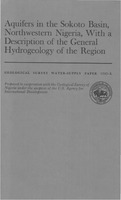The Sokoto Basin of northwestern Nigeria lies in the sub-Saharan Sudan belt of west Africa in a zone of savannah-type vegetation. Rainfall, averaging about 30 inches annually in much of the basin, occurs chiefly in a wet season which lasts from May to October. A prolonged dry season extending from October to April is dominated by dusty harmattan winds from the northeast. April and May are the hottest months, when temperatures occasionally reach 105?F.
Flow in streams of the Sokoto Basin is mostly overland runoff. Only in a few reaches, fed by ground-water discharge from the sedimentary rocks, are streams perennial. In the River Zamfara basin, ground-water discharge contributes almost 1 inch of the average 3.33 inches of total annual runoff. In the vicinity of Sokoto, the River Rima flows throughout the year sustained by spring discharge from perched ground water in limestone of the Kalambaina Formation. On the crystalline terrane where most of the streams rise, total annual runoff may exceed 5 inches, very little of which is ground-water discharge.
The sedimentary rocks of the basin range in age from Cretaceous to Tertiary and are composed mostly of interbedded sand, clay, and some limestone; the beds dip gently toward the northwest. Alluvium of Quaternary age underlies the lowlands of the River Sokoto (now Sokoto) and its principal tributaries. These rocks contain three important artesian aquifers, in addition to regional unconfined ground-water bodies in all the principal outcron areas, and a perched water body in the outcrop of the Kalambaina Formation. Artesian aquifers occur at depth in the Gundumi Formation, the Rima Group, and the Gwandu Formation and are separated from one another by clay beds in the lower part of the Rima Group and the Dange Formation. In outcrop, clay in the Dange Formation also supports the perched water of the Kalambaina Formation.
The Gundumi Formation, resting on the basement complex, is composed of varicolored clay, sand, and gravel and attains a thickness of 800 to 1,000 feet in its downdip extensions. Most of the formation is thin bedded and clayey and therefore does not yield large quantities of water to boreholes; the average yield is 2,700 gph (gallons per hour). (All gallons are imperial gallons.) Nevertheless, the upper part of the formation is sandy and more permeable and forms a regional artesian aquifer from which yields of as much as 6,600 gph are obtained from single boreholes. Clay in the lower part of the Rima Group confines the Gundumi aquifer downdip, so that at Rabah and Sokoto, for example, in the River Sokoto fadama (valley floor), artesian flow is found in boreholes screened in the Gundumi.
Aquifer tests indicate low transmissivities, ranging from 300 to 5,000 gpd per ft (gallons per day per foot) in the lower part of the Gundumi Formation; but in the upper sandy zone the transmissivities are much higher, reaching 66,000 gpd per ft. In the western part of the Sokoto Basin, more productive aquifers with higher heads usually lie above the Gundumi aquifer so that it is not attractive for development, except in the River Sokoto fadama where artesian flow is possible.
The Illo Group, which is in part contemporaneous with the Gundumi Formation, includes interbedded varicolored clay and grit in the southern part of the Sokoto Basin. The upper part of the Illo is known to be water-bearing; however, except for the test borehole at Mungadi, little is known of its subsurface extent and water-yielding potential.
Overlying the Gundumi Formation in the central and northern part of the Sokoto Basin are interbedded fine gray sand and dark gray clay of the Wurno and Taloka Formations, separated in the extreme north by clay shale of the Dukamaje Formation. Collectively known as the Rima Group, these sediments attain a thickness of more than 1,000 feet near the Niger border. At depth and downdip the clayey beds practically disappear; the sandy beds become thicker and coar


